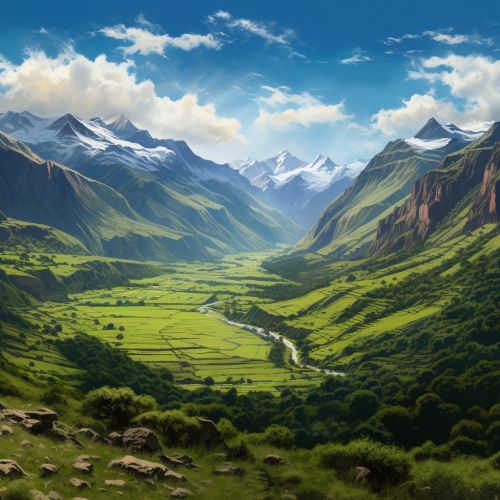Andes
Geography
The Andes is the longest continental mountain range in the world, traversing the west coast of South America. It stretches over 7,000 kilometers from the southern tip of Argentina and Chile to the northern coast of Colombia, passing through seven countries: Argentina, Chile, Bolivia, Peru, Ecuador, Colombia, and Venezuela. The Andes is also the highest mountain range outside Asia, with the highest peak, Aconcagua, standing at 6,962 meters above sea level.


Geology
The Andes is a result of tectonic activity where the Nazca and Antarctic Plates slide beneath the South American Plate, a process known as subduction. This ongoing subduction has resulted in the formation of the Andean Volcanic Belt and the creation of many of the Andes' highest peaks. The geology of the Andes includes igneous, metamorphic and sedimentary rock formations. The range is also rich in minerals, including copper, silver, and gold, making it a significant region for mining.
Climate
The climate in the Andes varies greatly depending on latitude, altitude, and proximity to the sea. It ranges from the dry Atacama Desert, one of the driest places on earth, in the west, to the wet Amazon Basin in the east. The Andes' high altitude affects the climate significantly, with cooler temperatures at higher elevations. The range also creates a rain shadow effect, causing variations in precipitation on the windward and leeward sides of the mountains.
Biodiversity
The Andes is one of the world's biodiversity hotspots, with a high level of endemism. It is home to a wide range of ecosystems, from the snow-capped peaks and high-altitude deserts to the cloud forests and tropical rainforests. The Andes is home to thousands of species of plants and animals, many of which are found nowhere else in the world. Notable fauna include the Andean condor, the spectacled bear, and the vicuña, which is the national animal of Peru.
Human History
The Andes has been home to various indigenous cultures for thousands of years. The most famous of these is the Inca Empire, which was the largest empire in pre-Columbian America. The Incas developed a complex society with impressive architectural and agricultural feats, including the city of Machu Picchu and the terraced fields of the Sacred Valley. The Spanish conquest in the 16th century brought significant changes to the region, including the introduction of new diseases, animals, and crops.
Modern Significance
Today, the Andes continues to be of great significance for its rich cultural heritage, biodiversity, and natural resources. It is a popular destination for outdoor activities such as hiking, climbing, and skiing. The Andes also provides essential resources such as water and hydroelectric power to the surrounding regions. However, it faces challenges such as climate change, deforestation, and mining activities, which threaten its biodiversity and the livelihood of the people who depend on it.
